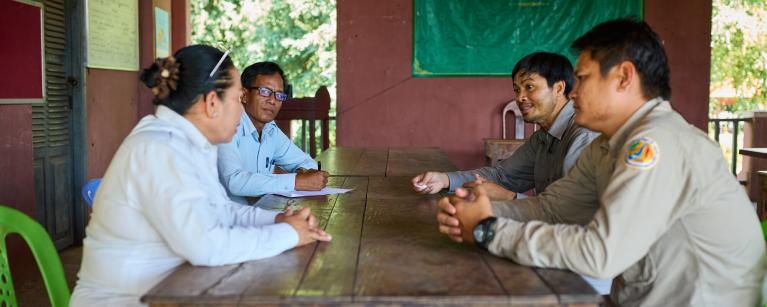Text by: Lin Hnin Aye
“Promoting women’s leadership in water governance is crucial for challenging gender norms, accessing power, creating safe spaces, addressing bias, serving as role models, and fostering collaboration. What can male colleagues contribute?“
Building male alliances and promoting male champions are crucial for supporting women leaders, breaking barriers, promoting equality, and improving water governance. This case study explores the efforts of Vannak, Deputy Director of Culture and Environment Preservation Association (CEPA), and Lany, Programme Coordinator of My Village MVi, who are dedicated to fostering gender equality and creating supportive environments for women’s active participation in decision-making. They address the gender disparity in community fisheries, where women’s involvement in decision-making processes is limited.
Safety and lack awareness are key challenges limiting women’s participation in decision-making role in water resource management, as recognized by Vannak and Lany. In community fisheries networks, women’s involvement is often associated with risky activities like patrolling but Vannak has clarified that women can contribute in diverse roles.
Vannak highlights the effective of providing gender training for committee members to raise awareness and challenge biases, promoting inclusive platforms. By engaging with local authorities and organizing meetings with the husbands of women leaders, an environment where women’s voices are respected and encouraged has been fostered. Building trust with the women he works with has been vital for community acceptance. Vannak emphasized clear communication and understanding the situations of their families as important factors in building strong relationships.
To address safety concern limiting women’s participation, Vannak and Lany have implemented safeguarding policies in their organizations to protect the well-being and rights of women involved in their initiatives. Lany emphasized the importance of prioritizing risk management and considering the safety of women and children in all activities. Understanding their specific needs and challenges is crucial in achieving this goal.
Over the span of ten years, Vannak’s journey in improving inclusive water resource governance has led to personal growth. “In 2017, when a young woman was assigned a leadership role through a women’s quota, I initially had concerns about her ability to lead older men who were skeptical of her capabilities. However, she defied all expectations and not only succeeded in the Community Fishery Community but also became part of the Mekong Women leadership. This experience has taught me a valuable lesson: we should never judge someone based on their age or gender. Instead, we should provide them with encouragement, orientation, and training, and then allow them to demonstrate their abilities,” he said.
The initiatives led by Vannak and Lany have brought about transformative change in promoting women’s leadership in water resource governance. Women network platforms and the inclusion of women focal persons in fishery committees at various level have created opportunities for women to contribute and advocate for gender equality. Recognition of women’s advocacy and negotiation skills has led to increased involvement in meetings at the village and national levels.
Ensuring the sustainability of these inclusive platforms is vital for women leaders to continue making a meaningful impact in their community. Lany emphasizes the identification of new tools such as Female Participatory Action Research (FPAR) to promote women’s inclusion and engage the community simultaneously, fostering an empowering environment that recognizes women’s contributions.
To further advance gender equality and inclusivity in water governance, it is important to encourage more men to become advocates for women leaders. By working together, we can build a future where women’s voices are heard, respected, and valued in decision-making processes, leading to more effective and inclusive water governance systems.
